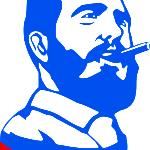Cuba’s horse racing industry once flourished at the country’s only horse racing track, Oriental Park. Oriental Park Racetrack opened in 1915 and was operated by the Havana-American Jockey Club of Cuba. It was open during the winter months and many of America’s top stables brought their best horses to Oriental Park Racetrack to compete. It’s also the track that gave future Hall of Famers Laz Barrera and Frank Martin their starts. The track thrived until the 1950’s, as it was a destination for celebrities and gangsters visiting from the U.S. and Europe. One could do a little gambling and imbibe as much liquor as they pleased (a practice banned in America from 1920-1933 during prohibition). As the race horsing industry started to take off in South Florida during the 1950’s, action at Oriental Park Racetrack started to decline. It was finally shut down in the early 1960’s after Fidel Castro came into power.
As relations between the U.S. and Cuba are restored, and American corporate money makes its way back to Cuba, (as we all know it eventually will) can we expect Cuba’s horse racing industry to flourish again? Probably not. First, they’ll need a race track! Yup, the Oriental Park clubhouse remains, but it’s currently being used as a government office. The grandstand has been torn down, and the land it once occupied is being used as a truck garage. Building a racetrack isn’t the problem though. Educating a nation that hasn’t seen or known horse racing for over 50 years is!
Cuba’s horse racing industry infrastructure would also need to be re-established, but given that gambling and drinking alcohol are no longer attractions for Americans, where will the demand for horse racing in Cuba come from? There’s a “if you build it, they will come” theory, but when was the last time you went to an indoor soccer or lacrosse game in the U.S.? Plus, there’s a bigger question. Does horse racing need gambling to be successful? Could a horse racing industry survive if there was no betting on the races? If the demand for horse racing in Cuba will have to be met internally rather than through visitors, they may have a big problem. The average Cuban citizen simply can’t afford to gamble. The average salary in Cuba is 471 pesos, which is equivalent to $20 U.S. dollars a month! That’s not a joke, and it’s also why Cubans risk their lives trying to float across shark infested waters (in home-made rafts) to get to Miami. So if you’ve got your eyes set on investing in the horse racing industry in Cuba, think twice. But don’t be totally bummed out.
We’ll let you in on a little known fact. There’s a government-owned breeding and training center called Rancho Azucarero which houses about 350 horses. Many of those horses are thoroughbreds. The talented thoroughbreds there are currently being sold off to racing interests in other Latin American countries. And that’s where the opportunity lies! First the American government will allow us to import some cigars and cheap alcohol, but soon, we could be finding ourselves with access to a whole new bloodline. And for non-racing fans, new breeds of horse will be available. There are four different breeds in Cuba known as “Crillo”: the Cubano de Paso, the Pinto Cubano, the Criollo de Trote and the Patibarcino. You can click on the link for a description of each.
So in short, normalized relations between the U.S. and Cuba should offer potential opportunities for stable owners in America. Track owners like Churchill Downs, however, should keep away for now. Those of you who work in the thoroughbred breeding industry in America can rest easy. Despite the ridiculously cheap wages, thoroughbred breeding is so entrenched in the United States that it would be too difficult to outsource it to Cuba. Plus, investors would always have to worry about Raul Castro (Fidel Castro’s brother and heir apparent) pulling a move out of his brother’s playbook, and nationalizing all foreign investments again.
Share This:







